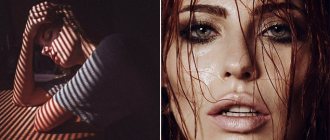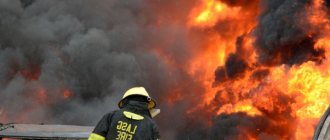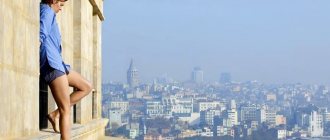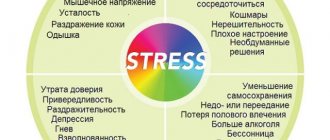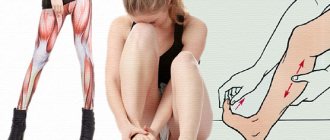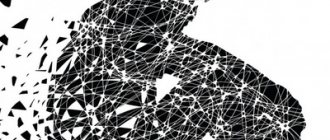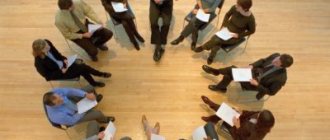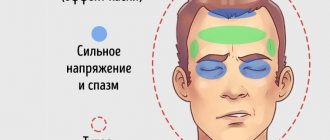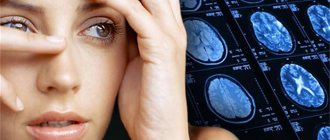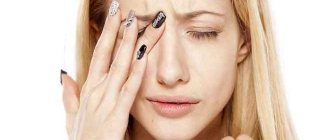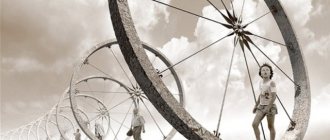Causes of fears
Phobias tend to worsen during times of severe stress on the nervous system. With VSD, fear hormones are released into the blood, which remain in it for some time. After the first attack, a person is afraid that these panic attacks (PA) will happen again. A vicious circle is formed - the more the patient is afraid of these attacks, the more often they occur.
Main phobias in people with VSD:
- fear of death;
- fear of another attack;
- fear of going crazy with VSD;
- fear of crowds and being in open and closed spaces;
- panic attacks (PA) in transport.
In addition, signs of VSD are:
- headache;
- weakness and chills;
- sleep disturbance;
- cardiopalmus;
- increased body temperature;
- dyspnea;
- lack of air.
In this condition, there is an intense release of adrenaline into the blood.
If at least 4 symptoms are detected, especially when there is a fear of death during VSD, the patient is worried about a panic attack. The patient begins to worry about his life. This condition is explained by the following: when the pulse increases, breathing failures occur, and the person becomes disoriented. Over time, the symptoms of the attacks intensify, and the feeling of fear takes deeper root. During PA, the following happens:
- strong fear appears;
- adrenaline is released;
- panic arises, which further increases the release of adrenaline;
- a panic attack occurs.
What is the way out of this situation?
Only a critical attitude towards yourself can lead to recovery! Only faith in your body, your hidden capabilities can not only get rid of the disease, but also strengthen the body as a whole.
Only truthful information about the disease itself, and VSD is still a disease, can help a person suffering from VSD take complete control of the information.
Only the ability to understand the nature of your thoughts can help you overcome this illness and become a socially active person who does not visit medical institutions.
You might also be interested in:
Normal or pathological?
It is normal for a person to be afraid of something. But fears can be justified or unfounded. The emergence of justified fears is due to the instinct of self-preservation. Unreasonable anxiety is the cause of phobias and occurs due to mental disorders. In a healthy person, the fear of death is groundless. But he doesn't appear out of nowhere. It usually occurs in those who have experienced a VSD panic attack for the first time.
Suddenly, a healthy person feels short of breath, tingling in the heart area and is in a pre-fainting state. His natural reaction is to fear for his life and health. Because of this, a person limits his exposure to unsafe situations, in the opinion of his subconscious. Often this safe and secure space is your own apartment.
A neurotic state is characterized by social phobia.
Fears in a patient with VSD are signs of neurosis. Phobias have no justified reasons for their appearance; the patient imposes this fear on himself. As a result, the functions of the nervous system are further disrupted, and the person is in constant stress. Symptoms of neurosis:
- irritability;
- agoraphobia;
- constant tension;
- social phobia;
- anxiety.
By getting rid of neurosis, a person will be able to eliminate fears. This is a complex process that requires a lot of effort and time.
How does acrophobia appear in VSD?
In most cases, the appearance of such a phobia is associated with some strong emotions or experiences. A person’s memory can block negative memories, while subconsciously fear is felt, as well as a strong desire to avoid such a situation.
That is, a person feels that heights are dangerous for him, but cannot explain why. Perhaps there was previously a fall from a height with subsequent injury, a strong fright from what he saw from a great height, a vivid scene in a film related to heights, or in reality.
Most phobias respond well to therapy. The main thing is to recognize the problem in time and not delay its treatment.
This often happens deep in childhood, when the child takes the situation to heart very emotionally, but it can also be caused at a conscious age.
Acrophobia is one of the most common phobias on our planet and affects thousands of people. The reaction of such a person is not only dizziness and nausea. You can observe a real panic attack - the inability to think and act adequately, sweating, trembling, shortness of breath, increased heart rate, severe anxiety.
Often people in such situations try to protect themselves as much as possible - they are afraid of falling, tripping, press themselves to the floor, close their ears and eyes, and refuse to move on.
What to do?
You can solve the problem with the help of a psychotherapist.
You can overcome fear during VSD with the help of psychotherapeutic sessions or on your own. To begin the fight against phobias, it is important to understand that the quality of life is influenced by a person’s way of thinking. You need to be positive and also:
- it is important to be able to relax and think about the good;
- normalize your schedule;
- It is useful to carry out breathing exercises.
When an attack of PA occurs, it is important to pull yourself together. Information will reach the subconscious that a certain situation does not pose a danger to health and life, and the vicious circle will be broken. To normalize the functionality of the nervous system, drug treatment is used. But its effect is possible only with the efforts of the patient and his positive attitude.
Drugs
For VSD, medications are prescribed, which are presented in the table:
| Group | Action |
| Sedative medications | They are of plant origin, so their calming effect is gentle |
| Antidepressants | Helps get rid of stress and psycho-emotional tension |
| Nootropics | Improves intellectual abilities, cerebral circulation and relieves tachycardia, disorientation, and increased blood pressure |
| Tranquilizers | Helps get rid of depression and phobias |
| They have a sedative effect, but at the same time inhibit the functions of the nervous system, manifesting themselves as drowsiness and inhibition of reactions. |
Vegetative-vascular dystonia of the hypertensive type: what is it and how to treat it?
VSD of the hypertensive type is a disease associated with disruption of the functioning of internal organs and resulting in an increase in blood pressure.
Comprehensive treatment consisting of exercise, a healthy diet, physical therapy and medications helps keep the disease under control.
Causes of the disease
As a rule, vegetative-vascular dystonia of the hypertensive type is manifested by increased blood pressure. Most scientists believe that this pathological condition is present in at least every second person.
People do not give much importance to the symptoms of the disease - nervous excitement, weakness, rapid heartbeat, attributing it simply to fatigue or a cold, taking homeopathic remedies, which in this case are powerless.
Vegetative-vascular dystonia can be diagnosed at any age. Moreover, women suffer from the syndrome at the age of 25-30, and men - starting from the age of 40. The risk group includes the category of people who constantly experience stress, move little, eat poorly and suffer from nervous or vascular disorders.
Classification
Description of VSD according to the hypertensive type
| Lightweight | The disease has no clear signs: there are no neurasthenic symptoms, and the ability to work is not reduced. There is a risk of progression to a more severe degree of the disease. |
| Average | Symptoms of VSD are more pronounced. Panic syndrome often appears, and performance deteriorates during the period of exacerbation of the pathology. |
| Heavy | The main symptom occurs – high blood pressure. During an exacerbation, the ability to work disappears altogether. There is a disruption in the functioning of the cardiovascular system and nervous regulation. |
This syndrome occurs as a result of the influence of many factors, namely:
- Strong emotional stress is the main cause of VSD. Constant stress leads to exhaustion of the nervous system and disruption of its functioning. This syndrome occurs as a result of the influence of many factors, namely:
- Genetics is the main factor influencing the development of pathology in childhood. Stress, lack of exercise and infections can aggravate the situation.
- Mechanical damage to the central nervous system - injury to the head or spine. Vegetovascular syndrome occurs when the vertebrae are displaced and nerve fibers are damaged.
- Infectious diseases - cytomegalovirus, herpes, etc. have a strong impact on the immune system. As a result, the functioning of the central nervous system is also impaired.
- Hormonal imbalance – endocrine system disorder, pregnancy, menopause, adolescence.
VSD can also be caused by excessive physical activity, lack of sleep, and the inability to alternate work and rest.
Symptoms of VSD of the hypertensive type
Blood pressure with VSD of the hypertensive type can reach a dangerous level - 200 mmHg. A very common misdiagnosis is arterial hypertension.
Sharp pressure surges occur during VSD, which quickly return to normal values. Therefore, a medicine that has a hypotonic property often cannot relieve high blood pressure. A rapid increase in pressure (vegetative crisis) is caused by the release of adrenaline. Its main difference from a hypertensive crisis lies in the reasons - severe fear, fright, excitement, etc.
An increased arterial pulse is not the only sign of VSD of the hypertensive type, which causes migraine, dizziness, asthenia, spots before the eyes, and irritability. Associated symptoms may include:
- A panic attack is a feeling of fear that can last from 15 minutes to 3 hours.
- Decreased brain activity – memory impairment, deterioration in concentration, difficulty forming a thought.
- Digestive disorders – stool disturbances, attacks of nausea, vomiting, abdominal pain.
- Other symptoms include difficulty breathing and increased sweating.
There is often confusion with a disorder such as neurocirculatory dystonia of the hypertensive type - an abnormal condition of blood vessels in which the neurological regulation of their tone is disrupted. The pathology is characterized by moderately high systolic blood pressure and normal or slightly low diastolic blood pressure.
NCD of the hypertensive type occurs as a result of prolonged stress, intracranial injuries, physical overexertion, lack of sleep, acute infections, severe diseases of internal organs, and physical inactivity. Neurocirculatory syndrome occurs more often in people with vascular diseases, for example, cardiac ischemia, angiopathy, hypertension, etc. The clinical picture is similar to vegetative vascular dystonia of the hypertensive type
Also, as a result of hormonal imbalance, cerebral angiodystonic syndrome develops in young women and school-age children.
Principles of treatment of VSD
The disease requires emergency care as it can cause heart attack, stroke, weakened intestinal tone, erectile dysfunction, early menopause and many other complications.
Therapy includes three important components - a healthy lifestyle, physiotherapy and drug treatment.
The main preventive measures that can normalize blood pressure and improve the functioning of the central nervous system are:
- find a balance between work and rest;
- Sleep time should be 8-9 hours a day;
- organize moderate physical activity every day (running for hypertension, swimming, exercise therapy, back exercises, race walking, gymnastics, etc. will be useful);
- It is useful to take a contrast circular shower;
- limit TV viewing and reduce time spent near the computer - this will help avoid surges in blood pressure;
- the daily diet should be filled with fresh fruits and vegetables, cereals, low-fat cottage cheese, legumes, dietary meat and fish;
- you will have to reduce your intake of fatty, fried, pickled, salty foods;
- You need to give up bad habits - smoking and drinking alcohol.
Such recommendations will help prevent the thinning of blood vessels and stabilize the functioning of internal organs. In this case, the muscles will be in good shape, and the retina will be normal.
Physiotherapy includes methods such as therapeutic massage, acupuncture, balneotherapy (treatment with mineral water), darsonvalization (the effect of current on the body, helping to reduce blood pressure). The calming effect of such procedures improves the functioning of the vascular system and reduces anxiety. You can find out which procedure is better by reading reviews from patients.
As a rule, the doctor prescribes symptomatic therapy when non-drug methods cannot fight the disease:
- Antihypertensive drug – for high blood pressure.
- Nicerium, Oxybral, Cavinton - for dizziness.
- Venoplant, Detralex - for headaches.
- Beta blockers - for tachycardia.
- Tranquilizers, antidepressants - for increased nervousness and anxiety.
- Neuroprotectors, antioxidants – for asthenia.
- Vitamin and mineral complexes - to improve immunity.
- A folk collection based on herbs (valerian, lemon balm) - for calming.
Before taking the drug, you must visit your doctor. It must be remembered that no “magic pill” will cure the disease. Therapy must be comprehensive.
The best modern remedy for hypertension. 100% guarantee of pressure control and excellent prevention!
TO THE DOCTOR
how can I call you?:
Email (not published)
Subject of the question:
Question:
Last questions for specialists:
- Do IVs help with hypertension?
- If you take Eleutherococcus, does it lower or increase your blood pressure?
- Is it possible to treat hypertension with fasting?
- How much pressure should be reduced in a person?

